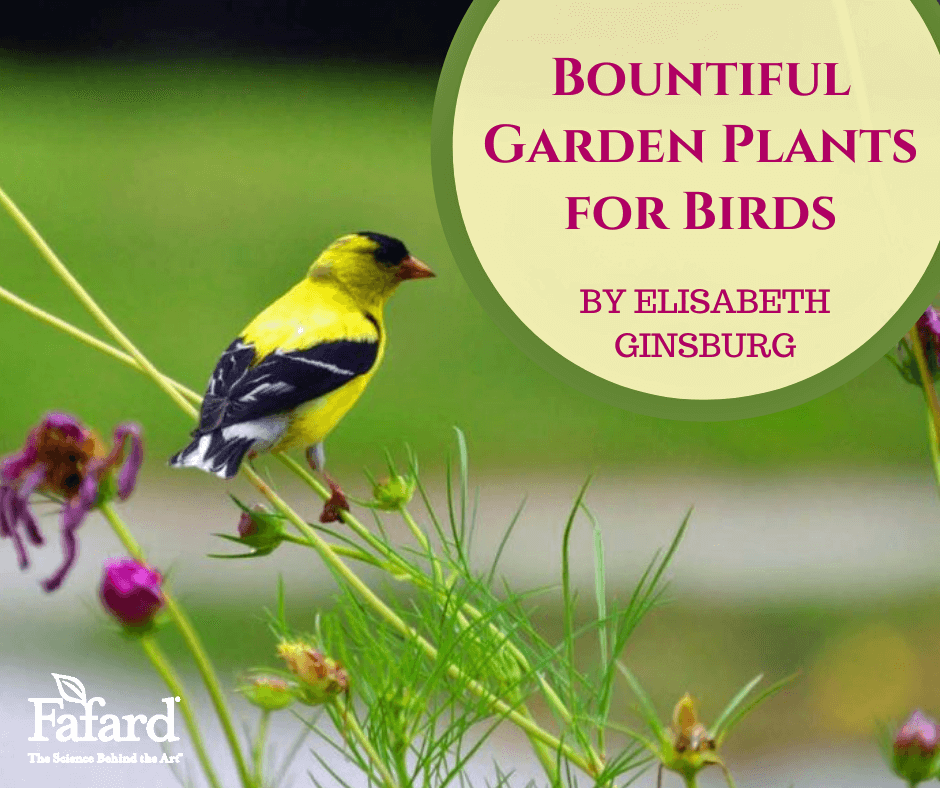
From wrens to cedar waxwings, birds inspire us with their flight and fascinate us with their songs. We can return those favors by creating bird-friendly environments in our own backyards, even if those “backyards” are terraces or balconies. All it takes is bountiful garden plants for birds and a small amount of garden care.
Basic gardening for birds comes down to a few necessities: food, water, shelter and an absence of poisons. Invest in birds and they will repay you handsomely.
Fine Dining for Birds

Bird feeders filled with sunflower and thistle seed are excellent but pricey food source for winged visitors. Birds also appreciate the more cost-effective approach of planting species that bear nutritious fruits, nectar, and seeds. A planting scheme that includes at least a few flowering and fruiting species native to your area ensures that the birds will have their choice of familiar foods.
Flowers for Birds–The current vogue for coneflowers (Echinacea spp. and Rudbeckia spp.) is great for seed lovers like American goldfinches and house finches that feast on the seed heads at the end of the growing season. Sunflowers (Helianthus spp.) and purple cosmos (Cosmos bipinnatus) do the same thing. (Click here to learn all about growing annual sunflowers!) Tubular red blooms, such as those of scarlet monarda (Monarda didyma) is a sure lure for passing hummingbirds. If you grow in containers, choose compact flowers for birds in Fafard Professional Potting Mix.
Vines for Birds–Almost every gardener has vertical space that might be perfect for plants like non-invasive, native coral honeysuckle (Lonicera sempervirens), which bears nectar-rich pink flowers that attract hummingbirds. Later in the growing season, the honeysuckle’s red berries are likely to catch the fancy of songbirds. If you have space, easy-to-grow Virginia creeper (Parthenosissus quinquefolia) can cover almost any structure or support while providing brilliant autumn leaves for humans and blue-black berries for avian friends.

Trees and Shrubs for Birds–Many shrubs and trees produce end-of-season berries, hips, and other fruits some of which persist into the winter, to sustain non-migrating birds like cardinals and waxwings. Forego deadheading your roses and they will provide you and the local birds with hips that are both attractive and nutritious. Dogwood trees (Cornus florida) beautify the spring garden with flowers and bear red berries in the fall as do flowering crabapples (Malus spp.). Deservedly popular and available in many shapes and sizes, Viburnums provide fruits for the likes of robins, cardinals, finches, and a host of other common birds. Shrubs like deciduous winterberry holly (Ilex verticillata), light up the winter garden and help keep birds alive in cold weather as do the copious bright red fruits of ‘Winter King’ hawthorn (Crataegus viridis ‘Winter King’).
Be a little untidy and let some leaf litter accumulate in at least a part of the yard or garden. This “litter” is good for the soil and harbors food for ground feeders like juncos and sparrows.
Plant Shelter Belts for Birds

Planting a mix of densely-branched shrubs and trees of varying heights helps birds of all sizes and habits find shelter and nesting sites. Evergreens like holly (Ilex spp.) and arborvitae (Thuja occidentalis) provide protection from the elements as well as food. Deciduous trees, including North American service berries (Amelanchier spp.) and crabapples (Malus spp.), feature dense branching, crooks, and hollows that make inviting nest sites.
And some of those nesting birds, like goldfinches, need the silky down from seeds like milkweed (Asclepias spp.) and thistle (Cirsium spp.) to line their nests. Gardeners have no need to plant thistles, but milkweeds are great garden flowers that attract butterflies and other insect pollinators.
Hydration Stations for Birds
Avian populations appreciate simple birdbaths, ground-level water dishes, or just about any water-filled vessel. Be sure to refill these backyard oases before they get dry and clean them regularly. Plants that hold drops of water on their leaf surfaces or in leaf or flower folds, like large-leaved hostas and calla lilies (Zantedeschia spp.), also offer drinks to birds.
Create Bird Safe Havens
Limit or completely curtail the use of pesticides and herbicides in your yard and garden to prevent chemical residue from disrupting the food chain and/or injuring birds. When expanding existing beds or planting new perennials, trees or shrubs, incorporate natural garden products like Fafard® Premium Topsoil, to enhance soil and plant health without posing a threat to wildlife. And, while it is impossible to stop all predators, you can improve the odds of avian survival by keeping domestic cats indoors. If feral cats are a problem, deter them with appropriate barriers.



